The ASUS TUF X99 Sabertooth Review
by Ian Cutress on July 22, 2015 10:00 AM EST- Posted in
- Motherboards
- Asus
- TUF
- X99
System Performance
Power Consumption
Power consumption was tested on the system while in a single MSI GTX 770 Lightning GPU configuration with a wall meter connected to the OCZ 1250W power supply. This power supply is Gold rated, and as I am in the UK on a 230-240 V supply, leads to ~75% efficiency > 50W, and 90%+ efficiency at 250W, suitable for both idle and multi-GPU loading. This method of power reading allows us to compare the power management of the UEFI and the board to supply components with power under load, and includes typical PSU losses due to efficiency. These are the real world values that consumers may expect from a typical system (minus the monitor) using this motherboard.
While this method for power measurement may not be ideal, and you feel these numbers are not representative due to the high wattage power supply being used (we use the same PSU to remain consistent over a series of reviews, and the fact that some boards on our test bed get tested with three or four high powered GPUs), the important point to take away is the relationship between the numbers. These boards are all under the same conditions, and thus the differences between them should be easy to spot.
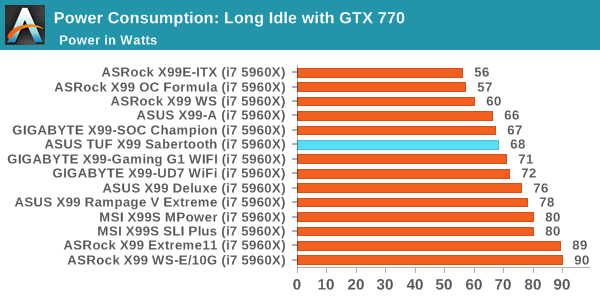

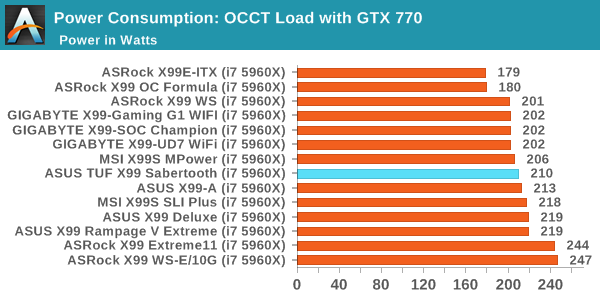
Power consumption overall was on the good side of average, though it didn’t break any records.
Windows 7 POST Time
Different motherboards have different POST sequences before an operating system is initialized. A lot of this is dependent on the board itself, and POST boot time is determined by the controllers on board (and the sequence of how those extras are organized). As part of our testing, we look at the POST Boot Time using a stopwatch. This is the time from pressing the ON button on the computer to when Windows 7 starts loading. (We discount Windows loading as it is highly variable given Windows specific features.)
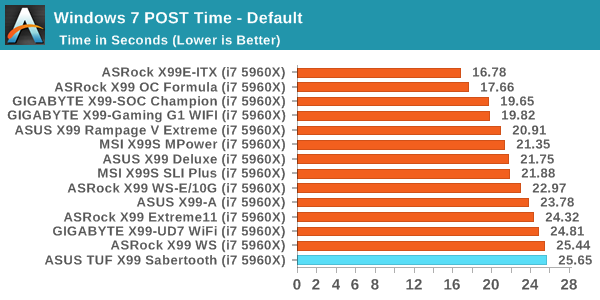
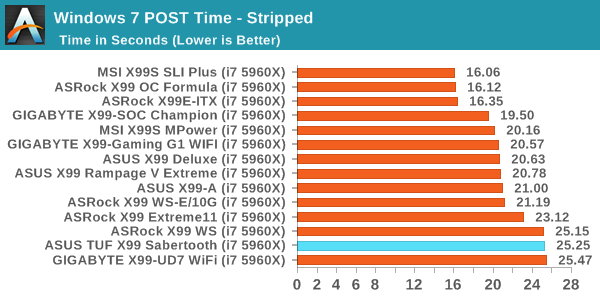
POST Time for the board was longer than most other X99 offerings, even when the Hyper Kit was not enabled. This might have something to do with all the temperature sensors and fan headers being detected and tested, along with DRAM training.
Rightmark Audio Analyzer 6.2.5
Rightmark:AA indicates how well the sound system is built and isolated from electrical interference (either internally or externally). For this test we connect the Line Out to the Line In using a short six inch 3.5mm to 3.5mm high-quality jack, turn the OS speaker volume to 100%, and run the Rightmark default test suite at 192 kHz, 24-bit. The OS is tuned to 192 kHz/24-bit input and output, and the Line-In volume is adjusted until we have the best RMAA value in the mini-pretest. We look specifically at the Dynamic Range of the audio codec used on board, as well as the Total Harmonic Distortion + Noise.
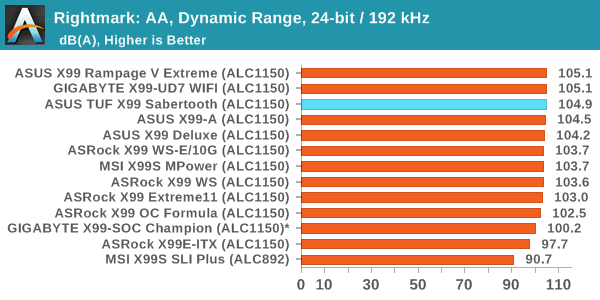
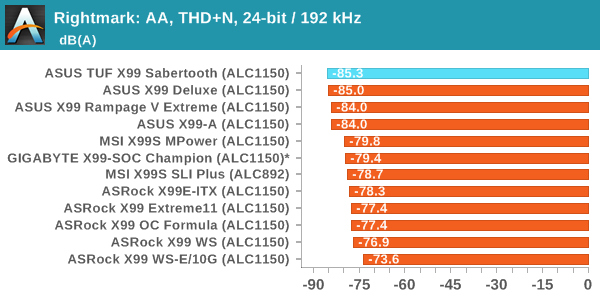
ASUS’ audio solution seems to do well in our tests.
USB Backup
For this benchmark, we transfer a set size of files from the SSD to the USB drive using DiskBench, which monitors the time taken to transfer. The files transferred are a 1.52 GB set of 2867 files across 320 folders – 95% of these files are small typical website files, and the rest (90% of the size) are small 30 second HD videos. In an update to pre-Z87 testing, we also run MaxCPU to load up one of the threads during the test which improves general performance up to 15% by causing all the internal pathways to run at full speed.
Due to the introduction of USB 3.1, as of June 2015 we are adjusting our test to use a dual mSATA USB 3.1 Type-C device which should be capable of saturating both USB 3.0 and USB 3.1 connections. We still use the same data set as before, but now use the new device. Results are shown as seconds taken to complete the data transfer. As this way of testing is still new, we have only a few results so far.
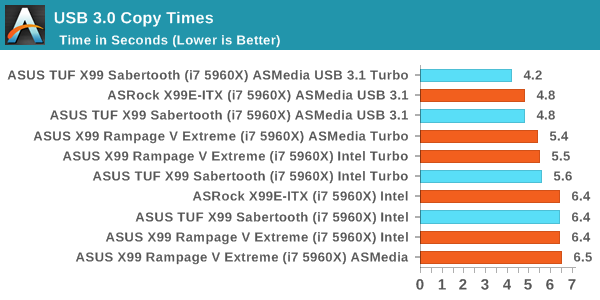
It’s interesting to see the effect of USB 3.1 turbo on our USB test, giving a marked benefit.
DPC Latency
Deferred Procedure Call latency is a way in which Windows handles interrupt servicing. In order to wait for a processor to acknowledge the request, the system will queue all interrupt requests by priority. Critical interrupts will be handled as soon as possible, whereas lesser priority requests such as audio will be further down the line. If the audio device requires data, it will have to wait until the request is processed before the buffer is filled.
If the device drivers of higher priority components in a system are poorly implemented, this can cause delays in request scheduling and process time. This can lead to an empty audio buffer and characteristic audible pauses, pops and clicks. The DPC latency checker measures how much time is taken processing DPCs from driver invocation. The lower the value will result in better audio transfer at smaller buffer sizes. Results are measured in microseconds.
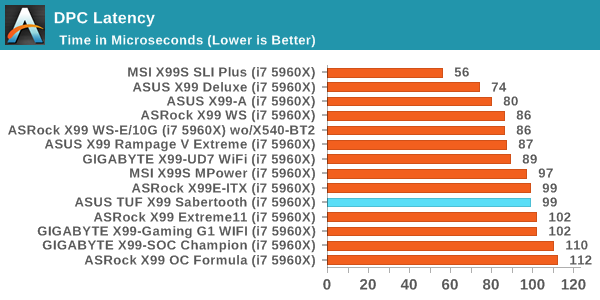
Less than 100 microseconds is a good DPC latency, although there are a number of X99 products that handily get a better result.
M.2 Hyper Kit
Due to Intel’s sampling, I happened to end up with the 2.5-inch version of the SSD 750 in hand when the X99 Sabertooth arrived. ASUS provided us with the Hyper Kit, and we went to task on the drive.
Our results pretty much match what Kristian had in his test of the PCIe device. In order to get the best speeds out of the device, we had to install Intel’s NVMe driver in the operating system as well. As noted previously in the review, in order to use this drive as a boot drive, the OS has to be installed by a UEFI enabled device and OS. My regular Windows W7 SP1 image for testing is not UEFI enabled, although a look through Google tells me that from W8 onwards all install disks should be UEFI capable. I tried with an old image of Win8 RTM and that worked fine.



















57 Comments
View All Comments
OldCOP - Tuesday, September 8, 2015 - link
that would also kill real advances in overclocking theory. Overclocking is not for someone who does not know what he is doing. If you must rely on "built in protection" you don't need to be overclocking.OldCOP - Tuesday, September 8, 2015 - link
It's the guns fault, not the NOOB that pulled the trigger ! Right? People need to take responsibility for what THEY do and stop blaming the manufacturer.Stuka87 - Wednesday, July 22, 2015 - link
He said how to get to the source (but has since now posted it).I find it pretty awesome that you were running X99 boards before they even started development on them.
superflex - Wednesday, July 22, 2015 - link
ASUS sockpuppet in the House!Six X99 boards operating for years?
LMFAO.
Does ASUS pay you in Hot Pockets?
bigboxes - Wednesday, July 22, 2015 - link
It was pretty funny. SIX Asus X99 boards. LOLGothmoth - Friday, July 24, 2015 - link
6 boards working since late 2014 make ~5 years of use.Desired Username #3 - Sunday, January 17, 2016 - link
Literally how? Are you adding up the time that you've owned the boards?Gothmoth - Friday, July 24, 2015 - link
well m*r*n...im a 3d freelancer doing jobs for architects.you ever heard about renderfarms?
distributed renderings? no.. well then get a clue.
so yes i need six x99 boards because i need lots of memory for my 3d scenes.
all boatds are equipped with 64gb of memory... ist how i earn my living.
not that a boy like you, who lives in his parents basement, would know anything about work or having a job.
so keep on wanking....
Ryangadz - Friday, July 24, 2015 - link
Have you looked into a GPU setup to do renderings? I know 3d studio max does it maybe Maya too. Workflow into those programs might not be ideal for your process but it could certainly save you a lot of time and money.I've always run dual CPU setups since 2002 for this reason but a GPU can be several times faster than even a dual Xeon for global illumination and raytracing.
itsallgoode9 - Wednesday, July 29, 2015 - link
GPU renderers generally aren't as fast as you'd think for interior renderings. Many other things, they are blazing fast (products, vehicles etc) but generally not interiors.I do product renderings for a living using Maya with Octane Render (GPU) and they work super fast for that. I was playing around with some interior rendering the other day and holy cow the speed drop from my product renders is substantial.
All my render programs are unbiased though, so if there's a biased gpu program out there, it might work much faster but then you're losing a lot of photo realism using biased.